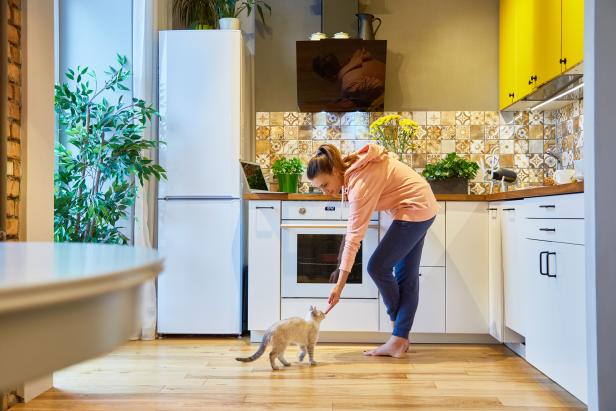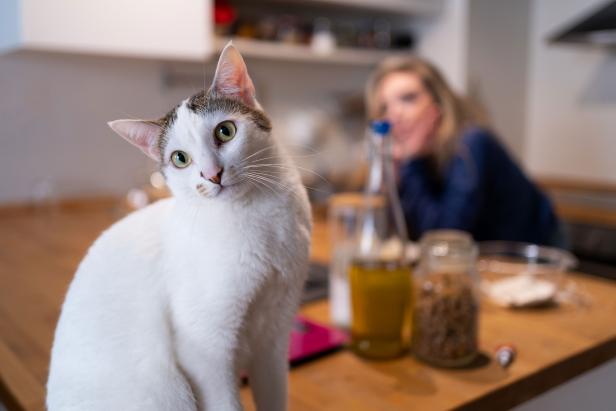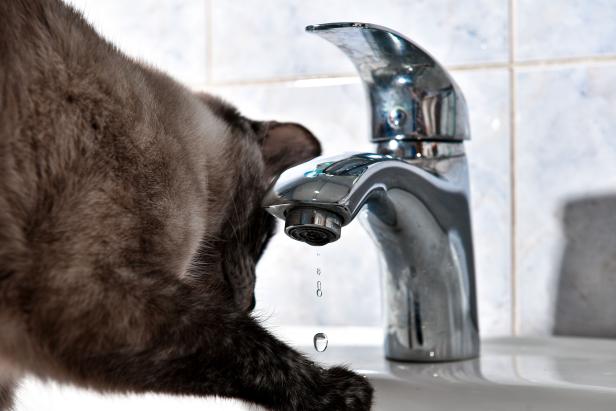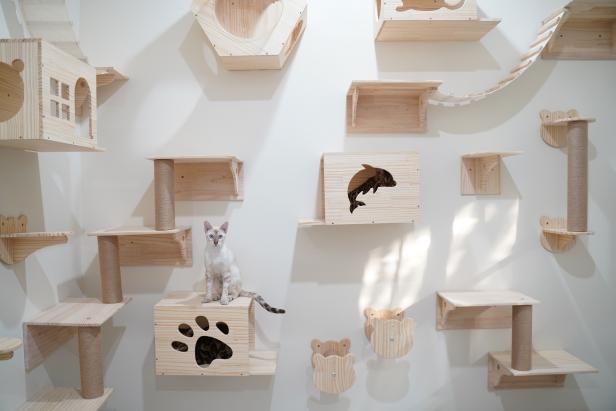How to Keep Cats Off Counters
Cure a case of kitty counter-hopping with these simple training and conditioning techniques.

There’s no denying that domestic house cats have primal instincts. From jumping on surfaces or catching mice, to sharpening their claws or chasing laser pointers, they know just how to keep their lives exciting. However, when our furry feline friends make a habit of jumping onto countertops and tabletops, pet owners are pressured to draw the line.

Shutterstock/ILIA KALINKIN
Cats are often lured onto the countertops for a specific reason:
- They like heights.
- They like treats.
- They're drawn to fresh running water from the sink.
- They're just curious and haven't been trained to know what's off-limits.
Correcting unwanted behavior can usually be accomplished by providing the pet alternative means to their goal, paired with positive reinforcement training. Frustrated owners should be patient and keep in mind that it really is possible to train your cats to stay off tables and countertops.

Shutterstock/Kazoka
Why Should Cats Not Be Allowed on the Counters?
Aside from the fact that you don’t want your cat to share from your charcuterie board while your back is turned, it’s important to keep bacteria and germs away from your food prep areas.
Though considered “clean” pets, cats carry bacteria on their paws from their adventures in and out of the litter box. Feces and related germs can transfer onto high-touch human areas and even into food, inviting illness, especially for pregnant women, elderly or those with weakened immune systems. Rest easier by setting better boundaries in your home to prevent cats from jumping onto kitchen counters and tables.

Shutterstock/Mbframes
How to Stop Counter Jumping
The first step to correcting bad cat behavior is identifying why they continue to get on the counter or table in the first place. Cats may be shifty, but there’s usually a motive. Once you know why they’re doing it, you can take steps to correct their behavior. All of these techniques can be used in conjunction with other training efforts.
Note that if a cat has access to the kitchen while you’re not around to provide reinforcement, it’s harder to reinforce both positive and negative behaviors. Focus on training when you know you can be an active, focused participant in the process, and try to keep the kitchen or dining room off-limits while you’re not around.
Keep Snacks Hidden
Foods and treats stored on the countertop are an easy draw for curious, hungry cats. Keeping snacks enclosed or behind cabinet doors is an easy choice. Out of sight, out of mind.
If your cat knows how to open cabinet doors, consider putting childproof locks on the knobs during the training process to thwart bad behavior.
Fix a Leaky Faucet
A dripping faucet often invites cats onto the counter; if you can fix it, that can help. That said, some cats learn to activate touch-activated faucets or turn knobs to turn on the water themselves.

Shutterstock/Jakob Schlegel
If your cat really loves a fresh water source, consider a kitty fountain to quench their thirst and appeal to their senses.
Apply Tape or Aluminum Foil
Sticky tape sheets or aluminum foil strips attached around the edge of a table or countertop can transform a cat’s landing area into an undesirable textured surface.
It’s not an ideal long-term solution, but if you’re away for an extended day and want to ensure that your pets are deterred from the counters or a particular tabletop, consider applying it to the surface to make it less welcoming.
Embrace Clicker Training
Clickers are used by many professional trainers in tandem with positive reinforcement. To be effective, training efforts must to be consistent. The cat must start by learning to associate the sound of the clicker with a positive response (a treat, for example). You’ll need to be present when using the clicker to discourage unwanted behavior. With consistency comes success.
For some cats, a flashlight or laser can be used for positive reinforcement instead of an audible clicker.

Shutterstock/Tara Patta
Provide Another Climbing Opportunity
Cats love heights, and counters and shelves are like Everest. Instead, invite your cat to play with another high perching area, such as a vertical cat tree or kitty condo with a cozy resting nest. Use positive reinforcement training to encourage the cat to choose that platform rather than a countertop.
You might also know that your pet favors watching the outside world. If so, consider an outdoor “catio.” Some products are freestanding and usable outdoors, while other cat solariums attach to a window to offer indoor cats a better view.
More Tips for Cat Owners
12 Cool Catios for Every Feline, Style and Budget
Give your cat a safe place to explore, lounge and play outdoors with these catios and enclosures.
How to Make a Cat Condo
Use PVC pipe, wicker baskets and basic tools to build a fancy cat jungle gym.
7 Plants to Grow for Cats
Fill your home with these feline-friendly herbs and flowers.













































